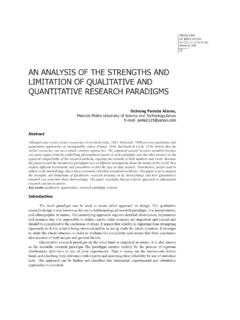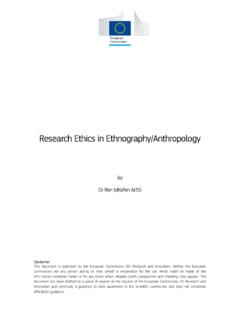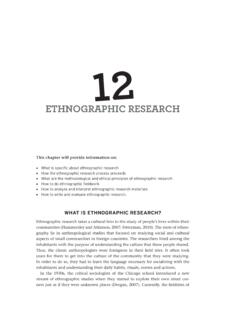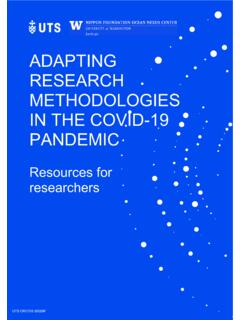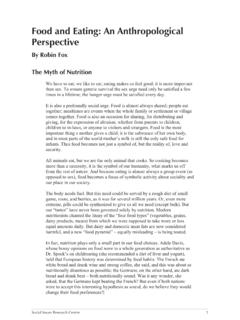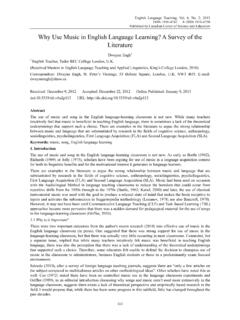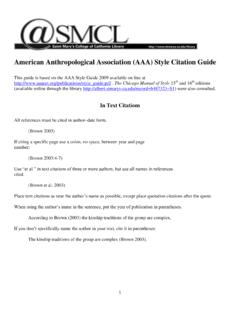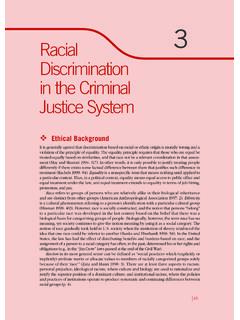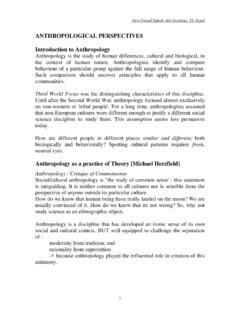Transcription of Anthropological Research Methods - SESYNC
1 Anthropological Research Methods Michael Paolisso University of Maryland, College Park Department of Anthropology Anthropology Immersion Workshop National Socio-Environmental Synthesis Center Feb 29, 2016. Anthropological Research Methods : Caveats and Promises Wide range of Methods depending on theoretical orientation and problem Methods vary depending on subfield of anthropology (socio-cultural anthropology). Methods have multidimensional flexibility depending on epistemological and ontological positioning Methods provide a fundamental platform from which to engage in trans-disciplinary and synthesis Research Handbook of Methods in Cultural Anthropology (Bernard & Gravlee 2015).
2 Research Methods : Principles and Practices Holism Cultural relativism Fieldwork Ethnography Multi-sited Large tool kit People Centered Culture, Structure and Process Holism Meaning, understanding and behavior are generated by interconnections of a whole The specific cannot be understood without reference to that whole, or some subset of that whole Reductionism and parsimony are suspect unless holistically contextualized Cultural Relativism Resistance to universal assumptions about socio-cultural processes Focus on cross cultural or group patterns and also exceptions and alternatives to those patterns Provide a voice and articulate value to socio- cultural phenomena in marginalized, under- served and under-represented populations Focus on inter-cultural or group patterns of agreement and disagreement Fieldwork.
3 Then and Now The real- world places for engaging pe0ple;. Still fundamental to our discipline both Margaret Mead and Gregory real and Bateson, New Guinea 1938 imagined;. Opportunity Susan Crate, Pacific Islands for grounding (2012). and validating our theories, Methods , and goals;. Professionally and personally challenging Bronislaw Malinowski, Joshua Bell, Papua New Guinea (rite of Trobriand Islands (1918) (200s). Ethnography Empirical grounding of our Research during fieldwork Engaged, inductive and reflective Focused but flexible Triangulation of practices and tools Participatory and Collaborative Multi-Sited Ethnographic fieldwork across more than one geographic, community or institution site Examination of linkages among sites at different spatial and temporal scales Focuses on inter-site flows of knowledge, values, power, materials and their human and environmental consequences (justice, decisions, polices).)
4 Methodological Toolkit Participant Observation Interviews and Surveys Qualitative-Quantitative Analysis Modeling Participant Observation A defining method for anthropology Participate in and observe people and groups The anthropologist as instrument or interlocutor Data or information subject to post modern, scientific and humanistic analysis Stand alone or complementary to other Methods Interviews and Surveys Use informal interviews to identify relevant issues and topics and to complement participant observation Key informants and collaborators Very open ended Use semi-structured interviews to simulate natural discourse Large group of experts that represent diverse views (n=10-40).
5 Set open-ended questions asked to all with probing Non quantitative but amenable to qualitative analysis/modeling Surveys Developed from interview data for statistical and model analysis Used to transition from subset of interviewees to larger populations Results validated and interpreted using qualitative interview and p/o data Anthropological Modeling Examples Text Model: Harmful Algae Bloom Text Models ( ). Cultural Modeling Cultural Consensus Social Network Analysis Complex Adaptive Systems Agent Based Modeling Participatory GIS.
6 Outcomes of Methodological Goals, Principles, and Practices Ethnography or case study Comparative Research Inter- and trans-disciplinary Research Participatory and collaborative Research Valuation and agency of knowledge, values and practices within and between groups Attention to structures and processes across time and space Methods tell much about Anthropology We produce ethnographies and people-centered accounts Our Methods organize our goal to talk and understand people and their contexts Produce data that are valid ethnographically Essential to evaluating our theoretical assumptions Thanks

